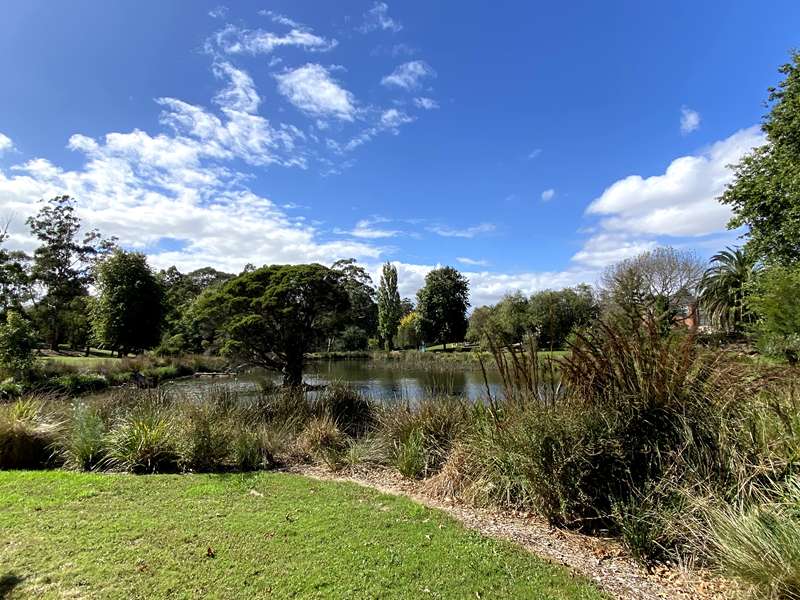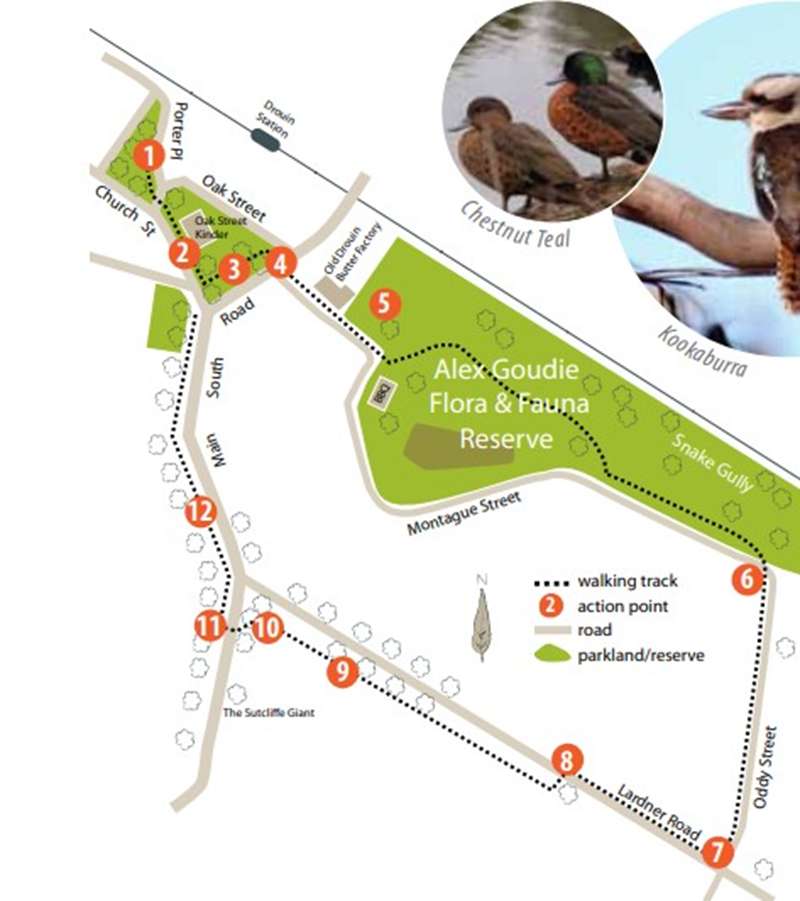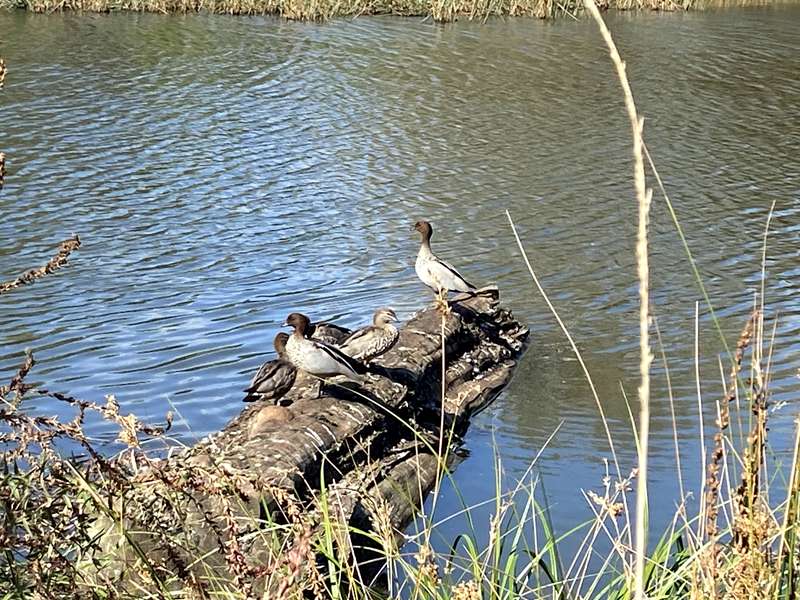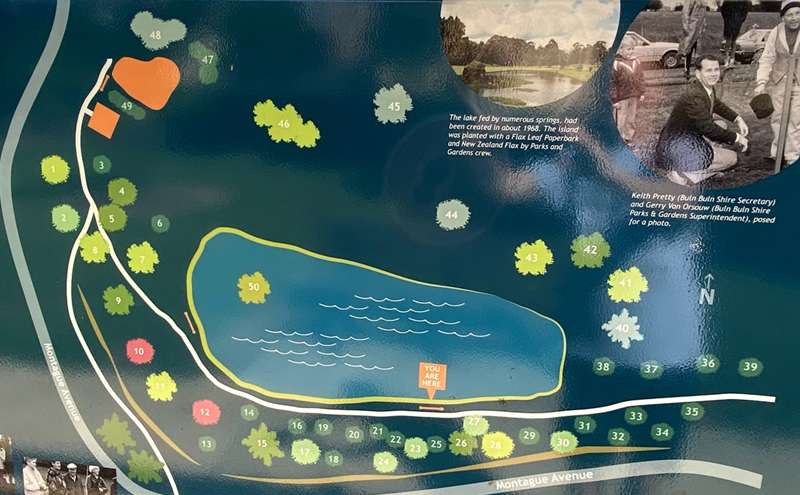Drouin - Trees of Many Nations Walk


A fairly level 2.0km walk with only one short uphill section. This route highlights some of the old planted trees of Drouin including oaks, planes and elms in avenues as well as superb remnant trees in bushland settings. The lower bush areas can be wet in winter.
Trees of Many Nations Walk Map

1. Start at Porter Memorial Park. This park area has 12 deciduous trees, mostly English Elms and English Oaks planted early in the 1900s. The large flowering gum which is approximately 60 years old was used by the Buln Buln Shire for seed stock. The park has a shelter with seats.
2. Walk south east along Porter Place on the path outside the Oak Street Kinder. These four beautiful old oaks were planted for shade, early in the 1900s when this area was the site of the sale yards of the district. These trees have trunk girths of approximately 3 m and are 18-20 m high.
3. At the last oak, walk into the little area known as J.C. Wells Park and walk to Oak St. You will see a Silky Oak about 60 years old, planted in the 1950s. Nectar feeding birds love the flowers.
4. Cross carefully over Main South Rd at the crossing point and walk down the shared roadway past the Old Drouin Butter Factory.
5. Alex Goudie Flora & Fauna Reserve and the Trees of Nations is ahead. This park was named in honour of Alexander Goudie who was three times Buln Buln Shire President. He had a strong commitment to the improvement of Drouin's environment The park is set around existing natural springs which form the lake and become the headwaters of Gum Scrub Creek crossing under the railway line just east of the park. In July 1988 as part of Australia's Bicentenary, trees were planted to acknowledge the various nationalities of people living in the Buln Buln Shire (cypresses, horse chestnut, golden rain tree, palms etc) and was called 'The Trees of Nations: Stay to the north of the pond and walk through grassy parkland to the east end of the park. The parkland flows into 'Snake Gully' known as such for the snakes which came in on timber delivered to the old Drouin Butter Factory, and which slithered off down into the gully. This area has about 150 large native eucalypts - Mountain Grey Gums, Messmates, Strzeleckii Gums and Peppermint Gums. The grove of large gums at the end of the gully was once home to koalas in the early 1900s.


6. Walk uphill along Oddy St to Lardner Rd.
7. Turn right and head down Lardner Rd to no. 43.
8. Cross over to the south side. Outside the factory are two Flax-leaf and one Prickly-leaf Paperbark. The largest Flaxleaf, a superb example opposite no. 37, has a trunk girth of 1.5 m and is estimated to be 70 years old. It is covered in white flowers in summer. Stop and look up into the canopy. Ironically the Flax-leaf has a rough bark and the Prickly-leaf has smooth bark. The Lardner Road Drouin Butter Factory was built in 1939. At the height of its era it became the largest single supplier of milk to the Melbourne markets.
9. Keep walking down Lardner Rd. The avenue of twenty Plane trees with grey mottled trunks planted in the 1930s has been 'pollarded'. Pollarding involves pruning the upper branches, promoting a dense head of foliage. They have a 'balled' canopy shape in summer.
10. At the driveway of 1 Lardner Rd are two Norfolk Island pines which were planted by John Sutcliffe in 1889 for his house 'The Orient'. Mr Sutcliffe was a prominent early pioneer, councillor and businessman.

11. Cross over Main South Rd at the crossing point. Turn around and look back to the remnant Mountain Grey Gum, known as the 'Sutcliffe Giant' which sadly died but has been preserved as a habitat tree by the Baw Baw Shire.

12. Walk down this side of the road past the store, back towards your starting point. There are 21 heritage listed mature English Elms planted in a row early in the 1900s, which still provide a pleasant shady avenue.
'Trees of Nations'
In 1988 as part of Australia's Bicentennial Celebrations, the 'Trees of Nations' was established and trees were planted here to acknowledge the various nationalities of people living in the Buln Buln Shire. Thirty trees were planted on the south side of the lake in two rows. The first tree, a Silver Wattle, was planted by Euphemia 'Ma' Mullett. The official ceremony was held Saturday 30th July 1988 with the Shire President Cr Vin Bibby officiating.
After 30 years only 10 trees from the original 30 had survived. The 2020 renewal project aimed to fill the gaps and to also plant trees to represent the nations of new residents who have since made Drouin and Baw Baw Shire their home. The renewal ceremony was held Saturday 1st August 2020.
The trees in this park are diverse in species, shape, size and colour. They are a reflection of the diversity of the people who live in this town and Shire. In 2020 and beyond let us celebrate our diverse backgrounds and unite together as Australians who love this place we all call home.
Alex Goudie Flora & Fauna Reserve Tree of Nations Map

1. Pin Oak Quercus patustris
2. Caucasian Oak Quercus macranthera
3. White Cedar or Pride of India Melia azedarach
4. Weeping Lilly Pilly Waterhousea floribunda
5. Weeping Lilly Pilly Waterhousea floribunda
6. Kanooka or Water Gum Tristaniopsis laurina
7. Pin Oak Quercus palustris
8. Pin Oak Quercus palustris
9. Oak Species Quercus sp
10. Scarlet Oak Quercus coccinea
11. Pin Oak Quercus palustris
12. Scarlet Oak Quercus coccinea
13. Strzelecki Gum Eucalyptus strzeleckii
14. Judas Tree Cercis siliquastrum
15. Canary Island Palm Phoenix canariensis
16. Ornamental Pear Pyrus calleryana chanticleer
17. Manna or Flowering Ash Froxinus ornus
18. Canadian Maple Acer rubrum
19. Lime Tree Tilia cordata
20. Olive Tree Oleo europaea
21. Strawberry Tree Arbutos unedo
22. Silver Birch Betula pendula
23. Silver Birch Betula pendula
24. Silver Birch Betula pendula
25. Jacaranda Jacaranda mimosifolia
26. Oak Species Quercus sp
27. Cork Oak Quercus super
28. Golden Elm Ulmus glabra 'lutescens'
29. Chinese Pistachio Pistacia chinensis
30. Poplar Populus nigra
31. Japanese Elm Zelkovo serrate
32. Peruvian Peppercorn Tree Schinus molle
33. Horse Chestnut Aesculus hippocostanum
34. Pohutakawa Metrosideros excelsa
35. European Beech Fagus sylvatica
36. Parrot Tree/Weeping Boer Bean Schotia brachypetala
37. Blue Spruce Picea pungens
38. Tupelo Nyssa sylvatica
39. Rowan Tree Sorbus aucuparia
40. Norway Spruce Picea abies
41. Honey Locust Gleditsia triacanthos
42. Cutleaf English Oak Quercus robur 'Filicifolia'
43. Pin Oak Quercus palustris
44. Pin Oak Quercus palustris
45. Mixed native group Mixed species
46. Spotted Gum (group) Eucalyptus maculata
47. Rusty Gum (group) Angophora costata
48. Pink/yellow flowering gum (group) Eucalyptus leucoxylon
49. Camphor Laurel (group) Cinnamomum camphora
50. Flax Leaf Paperbark Melaleuca linariifolia
Access for Dogs:
Dogs are permitted on leash.
Review:
A lovely walk with the Alex Goudie Flora & Fauna Reserve being a total highlight. The reserve has a lake, playground and picnic facilities.
Apart from 'Trees of Nations' which are labelled, there are also 150 native eucalypts in the park. There are many trees which change colours during the seasons and would be wonderful in Autumn.
Photos:
Location
1 Porter Place, Drouin 3818 Map
Web Links
→ Drouin Tree Walks Brochure (PDF)
→ Birds of Drouin Brochure (PDF)
→ Birds of Drouin and District Brochure (PDF)
→ West Gippsland Flora Fauna and Fungi Brochure (PDF)
→ Baw Baw Shire Biodiversity Poster (PDF)
→ Nature On Your Doorstop Brochure (PDF)









